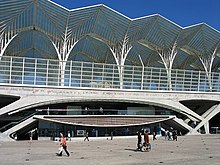Parque das Nações
| Parque das Nações | ||||||
|---|---|---|---|---|---|---|
|
||||||
| Basic data | ||||||
| Coordinates : | 38 ° 46 ′ N , 9 ° 6 ′ W | |||||
| politics | ||||||
| Website: | www.parquedasnacoes.org | |||||
The Parque das Nações [ ˈpaɾkɯ dɐʃ nɐˈsõĩʃ ], in German Park of Nations , is a municipality (freguesia) in the Portuguese capital, Lisbon . It includes the former exhibition grounds of Expo 98 . The area directly on the Tejo is still largely under the administration of the state ParqueExpo, SA and has developed into a new district with numerous cultural and sporting institutions after the World Exhibition. As part of the community reform, it was raised to a separate community on September 29, 2013.
terrain
Before the decision to convert the area on the Tagus into the site of a world exhibition, there were mainly large industrial companies. With the decision in favor of Expo 98 and its theme "The Oceans: A Legacy for the Future", coordinated by the Portuguese government and the Lisbon city council, the complete redevelopment began. The political authorities also rely on modern architecture for the Expo site in order to create a counterpoint to the “ Baixa de Lisboa ”, Lisbon's city center, and to establish the area as a new tourist destination. Re-use for all buildings was sought from the very beginning.
The Lisbon Oriente train station or Gare do Oriente , designed by Santiago Calatrava , is the focal point of the Parque das Nações . There are numerous train connections from the train station to almost all parts of the country, the Linha Vermelha of the Lisbon Metro ensures a connection to the city center. With the construction of the third Tejo bridge south of Parque das Nações and the new, direct connection to Madrid and the Algarve, the station will become even more important. To the west of the station is a large bus station operated by various Portuguese bus companies.


Via an underground access it is possible to get to the Vasco da Gama shopping center to the east of the train station , which is flanked to the north and south by the other landmark of Lisbon, the two 110-meter-high twin towers Torres São Rafael e São Gabriel . The shopping center, now managed by the Sonaesierra subsidiary of the Sonae conglomerate , served as a reception building for the world exhibition during Expo 98 .
To the east of the station, behind the shopping center, is the Pavilhão Atlântico , referred to as Pavilhão da Utopia during the Expo . Today it is a multifunctional hall; major concerts by well-known bands, for example, usually take place in this hall. To the north of this are the International Exhibition Halls, where the new Lisbon Exhibition Center (“ Feira Internacional de Lisboa ”) is located. To the north of the fair, the 145 meter high Torre Vasco da Gama offered a view of the Tejo and the Parque das Nações itself.
The site of the world exhibition also includes the former Future Pavilion ( Pavilhão do Futuro ), which now houses the Lisbon Casino, as well as the Knowledge Pavilion ( Pavilhão do Conhecimento ), now the Lisbon Museum of Science. One of the most famous buildings in Parque das Nações is the Oceanarium , which has a large selection of marine animals, such as sharks, rays, Caribbean fish as well as schools of tuna and sardines. The four corners of the Oceanário occupy replicas of certain regions. For example, there is an Antarctic area with penguins and an artificial glacier, but also a mangrove forest landscape.
Political development
The Parque das Nações like the surrounding buildings were part of the Freguesia Santa Maria dos Olivais in the Lisbon district and in the municipalities of Moscavide and Sacavém in the Loures district . With the advancing development of the area, voices increased to separate the area and form a new freguesia with the name Oriente. As part of the municipal reform in Portugal, the Parque das Nações was elevated to a separate municipality on September 29, 2013.
Web links
- Parque das Nações website (Portuguese, English, Spanish)
- Portal das Nações , media collection and further information on Parque das Nações (Portuguese)




